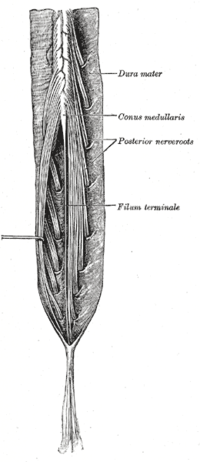
Photo from wikipedia
BackgroundBurst fracture is a common thoracolumbar injury that is treated using posterior pedicle instrumentation and fusion combined with transpedicular intracorporeal grafting after reduction. In this study, we compared the outcome… Click to show full abstract
BackgroundBurst fracture is a common thoracolumbar injury that is treated using posterior pedicle instrumentation and fusion combined with transpedicular intracorporeal grafting after reduction. In this study, we compared the outcome of these two techniques by using radiologic imaging and functional outcome.MethodsSixty-one patients with acute thoracolumbar burst fracture were operated with kyphoplasty (n = 31) or vertebroplasty (n = 30) and retrospectively reviewed in our institution between 2011 and 2014. All 61 patients underwent surgery within 5 days after admission to the hospital and then followed-up for 12 to 24 months after surgery.ResultsSignificant improvement was found in the anterior vertebral height (92 ± 8.9% in the kyphoplasty group, 85.6 ± 7.2% in the vertebroplasty group, p < 0.01) at 1 month post-operatively and (89 ± 7.9% in the kyphoplasty group, 78 ± 6.9% in the vertebroplasty group, p < 0.01) at the 24-month follow-up. Significant improvement was also observed in the kyphotic angle (1.2 ± 0.5° in the kyphoplasty group, 10.5 ± 1.2° in the vertebroplasty group, p < 0.01) at 1 month post-operatively and (5.4 ± 1.2° in the kyphoplasty group, 11.5 ± 8.5° in the vertebroplasty group, p < 0.01) at the 24-month follow-up. Both operations led to significant improvement of the patients’ pain and the Oswestry disability index (p < 0.01). Cement leakage was noted in 29% of patients after kyphoplasty and 77% of patients after vertebroplasty (p < 0.01). Only one implant failure (3.3%), which required further surgical intervention, was reported in the vertebroplasty group.ConclusionsReduction with additional balloon at the fractured site is better than indirect reduction only by posterior instrumentation. The better reduction of kyphotic angle and the lower cement leakage rate in the kyphoplasty group indicate that additional balloon kyphoplasty is safe and effective for acute thoracolumbar burst fracture.
Journal Title: BMC Musculoskeletal Disorders
Year Published: 2017
Link to full text (if available)
Share on Social Media: Sign Up to like & get
recommendations!